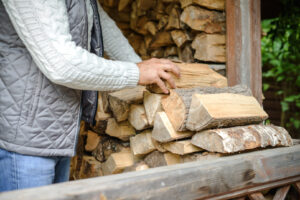
Let’s go over how to stack firewood for seasoning so your wood is ready to burn.
When preparing wood for seasoning, the most important things to know are how to stack firewood for seasoning and why you need to season wood in the first place. Not going through the seasoning process will result in green wood. Green wood does not burn well and can cause a chimney fire from too much creosote buildup. Well-seasoned wood logs are easier to burn and longer-lasting. Let’s go over how to stack firewood for seasoning so your wood is ready to burn.
Why Should You Stack Firewood?
Stacking your kiln-dried firewood is important because it will prevent moisture, mold, and pests. This is especially vital if you store your firewood outside. Throwing your wood into a pile allows moisture and pests to accumulate. Moisture in your firewood leads to mold, making it harder to burn and creating more smoke. If you store firewood inside, stacking it will keep your house clean. And if the wood is kiln-dried, you won’t need to worry about mold or pests.
The Importance of Seasoned Firewood
If your wood is not well-seasoned, then it won’t burn. Damp tinder is hard to light and won’t stay lit long. The purpose of seasoning firewood is to get better, cleaner-burning logs for your fireplace or wood-burner stoves. The seasoning process takes time and reduces the moisture content of your logs. A good location, sun, and circulating airflow are how to get good, seasoned firewood within 1-2 years.
Where to Stack Your Firewood
One of the most critical aspects of planning a backyard firewood project is finding the best location to start stacking logs. The best place to keep firewood is away from walls and near windbreaks to maximize airflow and sunlight. You should also keep your stack away from the side of your home. Pests look for shelter in wood stacks, so keeping it away from your home lessens the risk of an infestation or fire hazard.
How to Best Stack Firewood
Stacking freshly cut logs into single rows allows each piece to dry out, which is critical in the firewood seasoning process. You can create cross-stacked rows using irregular-shaped logs. Organizing your woodpile with a cross-stack method helps fresh air circulate every time the wind blows. Don’t stack your woodpile very high unless it’s supported by a fence or wall. Allow as much airflow as possible by using odd-shaped logs to create cross-stack channels for open-air drying. Also, pay attention to the size of the wood pieces. Place larger pieces at the bottom of the pile and smaller ones at the top to keep the structure stable.
Questions? Lehnhoff’s Supply is Here to Help
If you still have more questions about stacking firewood for seasoing, the trained professionals at Lehnhoff’s Supply are here to help you.
Find us at 2708 Belair Road, Fallston, MD 21047 and give us a call at 410-510-7646. For tips, tricks, and to see what we have been up to, be sure to follow us on Facebook, X – Twitter, and Pinterest!
We serve but aren’t limited to, the following parts of Maryland: Harford County – Fallston, Forest Hill, Joppa, Edgewood, Bel Air, Churchville, Havre de Grace, Jarrettsville, Street, Aberdeen, Abingdon, and Joppatowne. In Baltimore County: Kingsville, Perry Hall, Overlea, Fullerton, Nottingham, Parkville, Towson, Carney, Loch Raven, Lutherville, Timonium, Hunt Valley, Cockeysville, Sparks, Glyndon, Pikesville, Reisterstown, Ruxton, Parkton, Glen Arm, Baldwin, Monkton, Long Green, White Marsh, Rosedale, Phoenix, and Fork.
